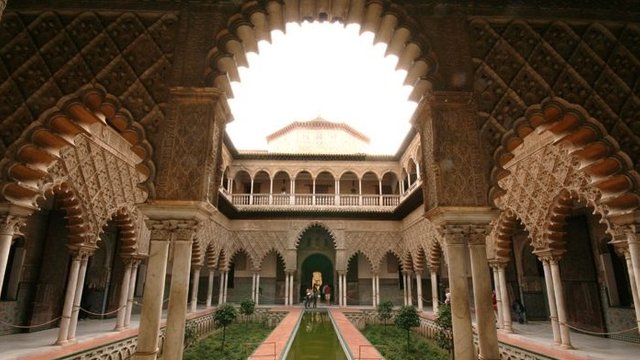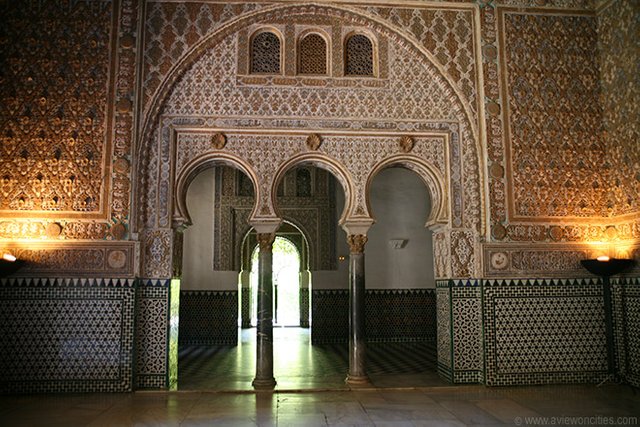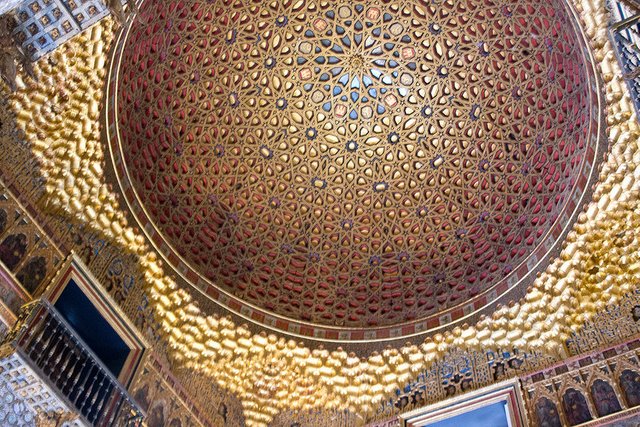STORY OF THE ALCAZAR OF SEVILLE
The Royal Alcázar (Real Alcázar) of Seville is a set of palatial buildings surrounded by a wall, located in the heart of the city of Seville. Its construction began in the early Middle Ages. In the course of history, its construction has involved different architectural styles, from the Islamic style of its early inhabitants to the Mudejar and Gothic style of the time after the conquest of the city by the Castilian troops. Renovations and baroque elements were added to the many renovations.
The enclosure has usually been used as housing for members of the Spanish royal family and the head of state visiting Seville. In 1972, the complex was declared a World Heritage Site, together with the Cathedral of Seville and the
General Archives of the Indies.
ISLAMIC PERIOD
The Alcazar began to look like a palatial fortress after the conquest of Seville by the Arabs in 712. By 720, they made it the residence of their rulers. In 884, the fortress helped to avoid a Viking invasion of the city.
Since its construction by the Arabs, the set included several enclosures (Casa de los Princes), residences that extended from the Plaza de Triunfo to the district of Santa Cruz (Barrio de Santa Cruz). The first Islamic palace dates from the same period as the Alhambra of Granada. It was enlarged by the construction of the residence of the emirs in the 11th century, as well as the addition to the 12th century of fortifications or the Palace of Blessings. A century later, the Almohads added patios and palaces. Currently, only the Patio del Yeso of the Islamic palace has been preserved.
CHRISTIAN PERIOD
After the capture of the city by King Fernando III in 1248, the Alcazar became a royal dwelling. It was Alfonso X the Wise (son of Fernando III) who undertook the first reforms after the reconquest, ordering in 1254 the construction of large Gothic salons. In 1364, Peter I of Castile built the so-called Palazzo Mudéjar, which became the first palace of a Castilian king who was not protected by the walls and defenses of a castle. This palace is well preserved and surprises by its architecture and the richness of the ornamentation that protects it. In 1366, when the construction of the new palace was completed, a civil war between Peter I and his half-brother Henry II of Castile broke out, leading to the death of the king. Although Peter I did not enjoy his palace for a long time, today it is considered to be the most complete example of Mudejar architecture in Spain. Subsequently, the Gothic Chapel, the apeadero, the Patio de la Montería (court hunting) and the gargoyles of the gardens were erected.
ALCAZAR AND THE SPANISH MONARCHY
Over the course of history the Alcazar (or Alcazars) have been the scene of multiple events in relation to the Spanish Crown. In 1477 it served as a place of residence for the Catholic Kings who arrived in Seville, and a year later, on June 14, Prince John of Aragon was born. In 1526, the Alcazar celebrated the marriage of Charles V with his cousin Isabella of Portugal.
In 1823, during the military intervention of the "Hundred Thousand Sons of Saint Louis" (name given to the French soldiers who came to occupy Spain), the Alcazar served as residence for the royal family of Fernando VII who had come to live in Seville.
By the decree of April 22, 1931, the government of the second Spanish republic ceded the Alcazar and its gardens to the city of Seville following a proposal by Minister Indalecio Prieto. The last event in connection with the monarchy took place on March 18, 1995 on the occasion of the luncheon and the reception of the wedding of Infanta Elena, daughter of King Juan Carlos I, with Jaime de Marichalar.




i would like to join the groupe @moon2011
Downvoting a post can decrease pending rewards and make it less visible. Common reasons:
Submit
@enitsirk
Downvoting a post can decrease pending rewards and make it less visible. Common reasons:
Submit
@originalworks
Downvoting a post can decrease pending rewards and make it less visible. Common reasons:
Submit
@tshering-tamang
Downvoting a post can decrease pending rewards and make it less visible. Common reasons:
Submit
@denisiya
Downvoting a post can decrease pending rewards and make it less visible. Common reasons:
Submit
@sgorenko
Downvoting a post can decrease pending rewards and make it less visible. Common reasons:
Submit
@dnpq
Downvoting a post can decrease pending rewards and make it less visible. Common reasons:
Submit
@har5h
Downvoting a post can decrease pending rewards and make it less visible. Common reasons:
Submit
This post has received gratitude of 0.60 % from @appreciator thanks to: @jawadovic.
Downvoting a post can decrease pending rewards and make it less visible. Common reasons:
Submit
@akhywali
Downvoting a post can decrease pending rewards and make it less visible. Common reasons:
Submit